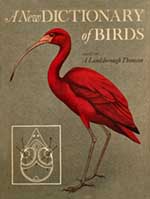
A New Dictionary of Birds
Edited by Sir A. Landsborough Thomson
McGraw-Hill, 1964
Although a dictionary in name, this stupendous volume is encyclopedic in scope. Numerous cross-references make this notable book of the utmost value. The many collaborators are specialists in their own fields and come from all corners of the globe. Most are renowned ornithologists having broad attainments and interests in scientific matters.
Articles of great interest both to the layman and scientist cover such diverse subjects as zoogeographic regions, ethology (behavior), classification, taxonomy, nomenclature, climatology, coloration, structure, disease, domestication, ecology, toxic chemicals (pesticides), adaptive radiation, eggs, parasites, evolution, molt, extinction, fossils, conservation, flight, genetics, imprinting (learning), migration, musculature, nests, speciation, numbers (density), plumage, ringing (banding), vocalization, anatomy, statistics, territory, mimicry, and numerous others. The treatment and discussion of the bird “groups” is made generally at the family or subfamily level.
Of great interest to students of distribution and evolution are the excellent articles on the zoogeographic regions: the Australasian by Serventy; the Oriental by Salim Ali; the Ethiopian by Moreau; the Palaearctic by Voous; and both the Nearctic and Neotropical by Mayr.
To the reviewer, one of the most fascinating articles is that on extinction by James Fisher, excellently summarized with tables.
The illustrative material varies in quality, but the many black and white photographs are superb. By and large the color paintings are attractive, those by Talbot-Kelly and Reid-Henry especially so. The illustration of the Screech Owl, however, done by another artist is barely, if at all, recognizable. A few errors inevitably crept in: on page 315 the figure labeled an Eastern Kingbird should be Scissor-tailed Flycatcher; on plate 8, the Rock Ptarmigan, figs. 3 and 4 are transposed— they should be “summer” and “winter” respectively; on plate 12 the corvid perched on a fish is appropriately enough, a Fish Crow, not a Common Crow (see Cruickshank, Birds around New York City, 1942, p. 319).
Landsborough Thomson is to be congratulated on organizing and editing this superlative volume, as well as contributing a number of major articles, altogether no small undertaking. The serious naturalist and birdwatcher will want to add this book to his library—a purchase well worthwhile.

